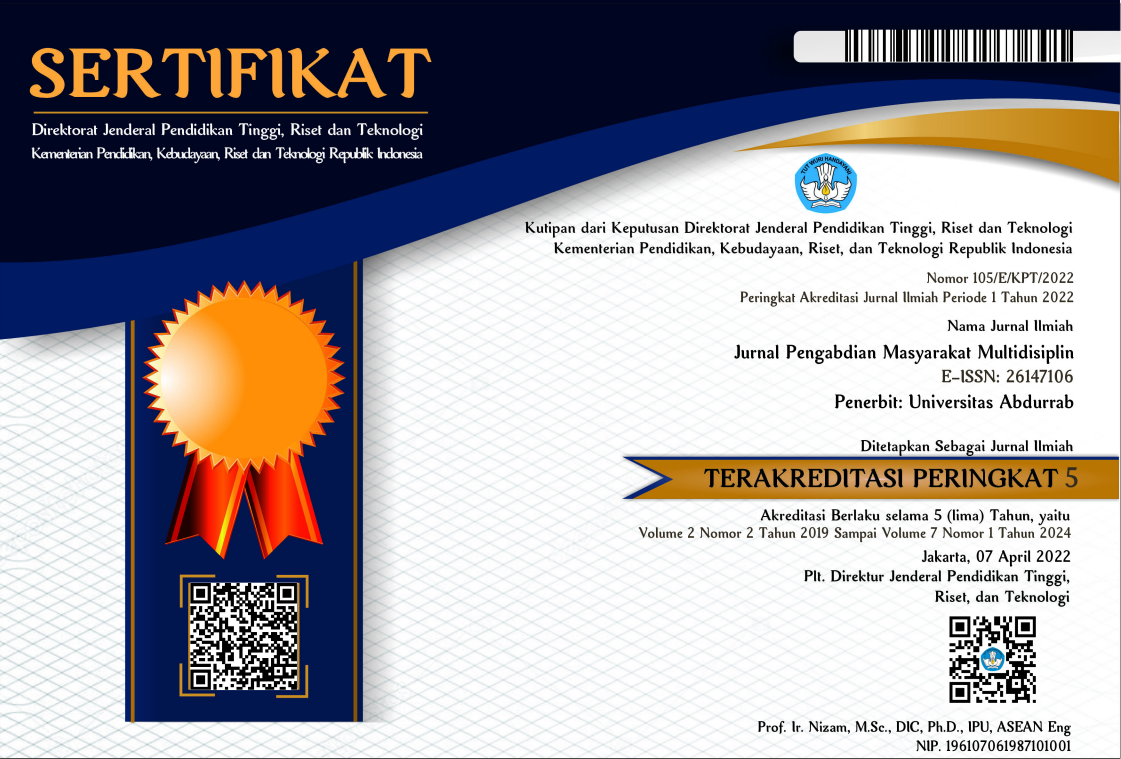PKM KELOMPOK PETANI PULAU-PULAU KECIL PEMBUAT BIOCHAR UNTUK PENINGKATAN PRODUKSI PALAWIJA
Abstract
Knowledge of farmers in small islands and farming communities in general about the management of agricultural waste for soil fertilizing agents is still low. Agricultural waste is often burned in the fields so that only ash is produced. In addition, the burning of agricultural waste results in the loss of many nutrients contained and can kill microorganisms that can fertilize the soil. Whereas the waste can be used to make biochar by slightly changing the way the waste is burned. Biochar can be used to overcome soil fertility problems to support food sustainability. The objectives of this community service activity are a) to introduce the benefits of biochar as a soil fertilizer to small island farmers and young farmers in Manding Laok Village; b) improve the skills of farmers and young farmers in making biochar using the simple stove method and closed-burning drum through training; c) application of biochar in growing media for vegetable crops. The PLA (Participatory Learning and Action) method is applied to the implementation of counseling, training, and demo plots of biochar application on vegetable growing media. ; c) partner farmers want to apply biochar to increase land fertility and crop production as many as 2 farmers. This activity needs a follow-up on the use of combustion smoke as liquid smoke for biopesticides.
References
A. A. Chandio and J. Yuansheng, “Determinants of Adoption of Improved Rice Varieties in Northern Sindh, Pakistan,” Rice Sci., vol. 25, no. 2, pp. 103–110, 2018, doi: 10.1016/j.rsci.2017.10.003.
Y. A. Dewi and R. Rahmawati, “Faktor-Faktor Yang Mempengaruhi Adopsi Teknologi Budidaya Kakao Di Nusa Tenggara Barat,” J. Pengkaj. dan Pengemb. Teknol. Pertan., vol. 22, no. 2, p. 185, 2020, doi: 10.21082/jpptp.v22n2.2019.p198-214.
I. Ekawati and dan P. Isdiantoni, “FAKTOR-FAKTOR YANG MENDASARI PETANI DI KABUPATEN SUMENEP,” vol. 8, pp. 8–14, 2011.
I. Ekawati and Isdiantoni, “Pertanaman Campuran Lahan Kering Spesifik Pulau Poteran: Penyediaan Pangan dan Pakan Ternak,” Prosiding Seminar Nasional Hasil Penelitian Sosial Ekonomi Pertanian, 2017.
J. Lehmann, M. C. Rillig, J. Thies, C. A. Masiello, W. C. Hockaday, and D. Crowley, “Biochar effects on soil biota - A review,” Soil Biol. Biochem., vol. 43, no. 9, pp. 1812–1836, 2011, doi: 10.1016/j.soilbio.2011.04.022.
J. Major, M. Rondon, D. Molina, S. J. Riha, and J. Lehmann, “Maize yield and nutrition during 4 years after biochar application to a Colombian savanna oxisol,” pp. 117–128, 2010, doi: 10.1007/s11104-010-0327-0.
and S. Masulili, A., W. Utomo, Journal of Agricultural Science, vol. 53, no. 9. 2010.
O. D. Nartey and B. Zhao, “Biochar preparation, characterization, and adsorptive capacity and its effect on bioavailability of contaminants: An overview,” Adv. Mater. Sci. Eng., vol. 2014, 2014, doi: 10.1155/2014/715398.
Nurhidayati dan Mariati, “J OURNAL OF D EGRADED AND M INING L ANDS M ANAGEMENT Utilization of maize cob biochar and rice husk charcoal as soil amendments for improving acid soil fertility and productivity,” vol. 2, no. 1, pp. 223–230, 2014, doi: 10.15243/jdmlm.2014.021.223.
N. L. Nurida, “Potensi Pemanfaatan Biochar untuk Rehabilitasi Lahan Kering di Indonesia Potency of Utilizing Biochar for Dryland Rehabilitation in Indonesia,” J. Sumberd. Lahan, vol. Edisi Khus, pp. 57–68, 2014.
Ritung, S. “Lahan Sawah dan Kecukupan Produksi Bahan Pangan,” J. Sumberd. Lahan, vol. 4, no. 1, pp. 27-38, 2010.
S. B. Scholz, T. Sembres, K. Roberts, T. Whitman, K. Wilson, and J. Lehmann, Biochar Systems for Smallholders in Developing Countries. 2014.
H. H. Siringoringo and C. A. Siregar, “Pengaruh aplikasi arang terhadap pertumbuhan awal,” J. Penelit. Hutan dan Konserv. Alam, vol. 8, no. 1, pp. 65–85, 2011.
A. Wijaya, T. Butarbutar, and W. Hartati, “Biochar Yang Diproduksi Dengan Tungku Drum Tertutup Retort,” vol. 2, no. 1, pp. 49–58, 2018.
Copyright (c) 2022 Jurnal Pengabdian Masyarakat Multidisiplin

This work is licensed under a Creative Commons Attribution-NonCommercial-ShareAlike 4.0 International License.
1. Copyright of all journal manuscripts is held by the Jurnal Pengabdian Masyarakat Multidisiplin.Formal legal provisions to access digital articles of electronic journal are subject to the provision of the Creative
2. Commons Attribution-ShareAlike license (CC BY-NC-SA), which means that Jurnal Pengabdian Masyarakat Multidisiplin is rightful to keep, transfer media/format, manage in the form of databases, maintain, and
3. publish articles.Published manuscripts both printed and electronic are open access for educational, research, and library purposes. Additionally, the editorial board is not responsible for any violations of copyright law.
licensed under a Creative Commons Attribution-ShareAlike 4.0 International License.
 PDF (Bahasa Indonesia)
PDF (Bahasa Indonesia)
 Abstract views: 308
Abstract views: 308
 downloads: 357
downloads: 357

 :
:




